
Transportation in the Philippines covers the transportation methods within this archipelagic nation of over 7,500 islands. From a previously underdeveloped state of transportation, the government of the Philippines has been improving transportation through various direct infrastructure projects, and these include an increase in air, sea, road, and rail transportation and transport hubs.
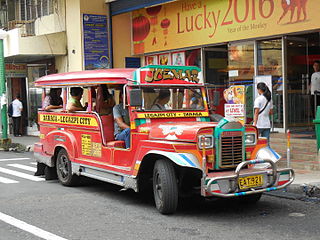
Jeepneys, sometimes called jeeps, are minibus-like public utility vehicles, serving as the most popular means of public transportation in the Philippines.They are known for their crowded seating and kitsch decorations, which have become a widespread symbol of Philippine culture and art. A Sarao jeepney was exhibited at the Philippine pavilion at the 1964 New York World's Fair as a national image for the Filipinos.
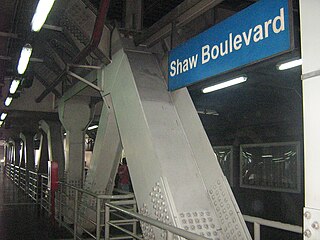
Shaw Boulevard station is an elevated Manila Metro Rail Transit (MRT) station situated on Line 3. The station is located in the Mandaluyong portion of Ortigas Center and is named after Shaw Boulevard, since the station lies directly above the boulevard. Being at the center of the whole line, many commuters regard Shaw Boulevard station as the "central terminal" of the line.

The Land Transportation Franchising and Regulatory Board is an agency of the Republic of the Philippines under the Department of Transportation (DOTr). The LTFRB was established on June 19, 1987, during the former president Corazon Aquino’s administration.

Ayala Malls is a retail subsidiary of real estate company Ayala Land, an affiliate of Ayala Corporation. Founded in 1988, Ayala Malls own a chain of large shopping malls, all located in the Philippines. Ayala Malls is one of the largest shopping mall retailer in the Philippines, along with SM Supermalls and Robinsons Malls.

The transportation system in Metro Manila covers the road network, rail network, ferries, ports and airports located with the metropolitan Manila area. Road transportation in Metro Manila is diverse, composed of many types of private and public transport vehicles. These include Taxis, buses, jeepneys, tricycles and pedicabs. In some areas, especially in Divisoria and large public markets, two-stroke motors are fitted in the pedicabs and are used for goods transport. Regardless of modernity, horse-drawn kalesas are still used in the streets of Binondo and Intramuros. Ridesharing services such as Grab also operate within in Metro Manila.

Joanna Jesh Transport Corporation (JJT) is one of the largest city bus companies in the Philippines. It plies routes from Food Terminal Incorporates in Taguig to Navotas.
De Guia Enterprises, Inc.,(G Liner) is one of the oldest city bus companies in the Philippines and is the oldest bus company operating in Manila. The company serves its routes along central Metro Manila areas (along with EMBC) and along EDSA corridor under Marikina Auto Line Transport Corporation (MALTC)

Dela Rosa Transit is one of the city bus companies in the Philippines. It plies route from Pacita Complex, San Pedro, Laguna to Novaliches, Quezon City. It also offers provincial routes operated under its sister companies, Dela Rosa Express and N. Dela Rosa Liner, plying routes from Metro Manila to Batangas City, Batangas, and Lucena City, Quezon, respectively.

HM Transport Inc. is one of the largest bus companies in the Philippines. It offers both provincial and city operations, servicing routes from Metro Manila to Laguna province and vice versa. Its city operation subsidiary, Worthy Transport Inc. services routes from Airport Loop, Pasay, Plaza Lawton, Manila Lagusnilad Underpass, FTI Complex, Taguig, Baclaran, Parañaque, Ayala Avenue, Makati and Pacita Complex, San Pedro, Laguna, all the way to SM Fairview in Quezon City.
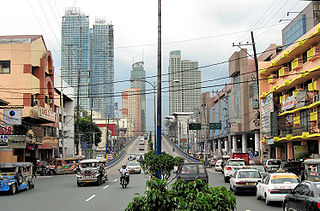
Shaw Boulevard is a 4-8 lane highway connecting the cities of Mandaluyong and Pasig in the Philippines. The boulevard is named after William James Shaw, the founder of the Wack Wack Golf and Country Club in Mandaluyong. The road is one of the major thoroughfares of the Ortigas Center in Mandaluyong and Pasig, housing many shopping malls like the Starmall shopping center and the posh Shangri-La Plaza at the EDSA-Shaw intersection and The Marketplace, which is visible from the Kalentong-Shaw intersection and Sevilla Bridge.

Alabang is a barangay in Muntinlupa, Philippines. At one time the area was a farming district, and has since grown from a village to a major commercial center, which includes the Filinvest City and Madrigal Business Park, and a transportation hub. It has an area of 8.064 square kilometers (3.114 sq mi). A large portion of Ayala Alabang came from Barangay Alabang. It is formerly the location of the Alabang Stock Farm.
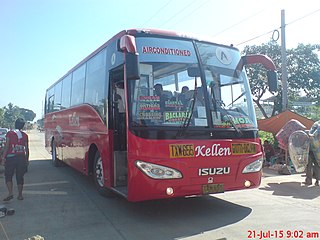
Kellen Transport Incorporated or simply KTI is a city bus company formed as a subsidiary of former Jell Transport, Inc. or JTI. It plies the previous routes from Baclaran, Parañaque to Grotto, San Jose del Monte, Bulacan. Now they operating in EDSA Carousel route under the ES Consortium. It's a subsidiary of ES Transport Inc., which a parent company operates both city and provincial operations.

The following is an alphabetical list of articles related to the Philippine capital region of Metro Manila.

The Premium Point-to-Point (P2P) Bus Service, formerly known as Express Connect, is an express bus service in the Philippines administered by the Department of Transportation and operated by private bus companies in partnership with the Land Transportation Franchising and Regulatory Board.
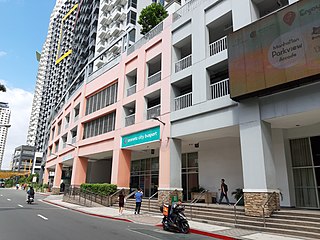
The Araneta City Bus Port (ACBP), also styled Araneta City Busport, is a bus station in Quezon City, Metro Manila, the Philippines. The bus station is currently one of two bus terminals in the Araneta City business district that link Metro Manila with the provinces in the north and south of the country, including cities in the Visayas and Mindanao via the Philippine Nautical Highway System.
















